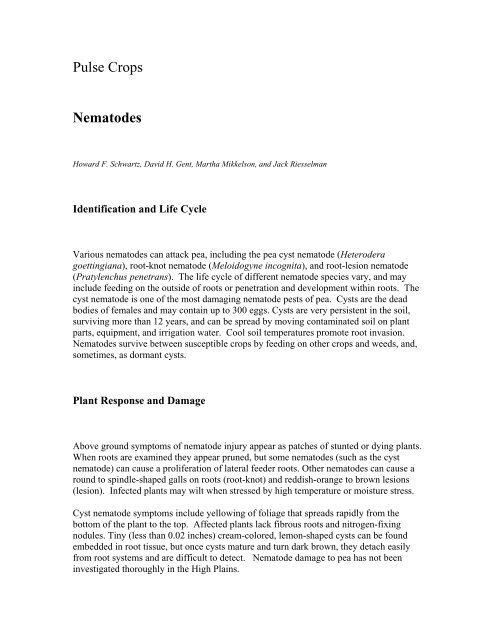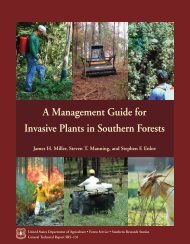Pulse Crops XXX - Nematodes
Pulse Crops XXX - Nematodes
Pulse Crops XXX - Nematodes
You also want an ePaper? Increase the reach of your titles
YUMPU automatically turns print PDFs into web optimized ePapers that Google loves.
<strong>Pulse</strong> <strong>Crops</strong><br />
<strong>Nematodes</strong><br />
Howard F. Schwartz, David H. Gent, Martha Mikkelson, and Jack Riesselman<br />
Identification and Life Cycle<br />
Various nematodes can attack pea, including the pea cyst nematode (Heterodera<br />
goettingiana), root-knot nematode (Meloidogyne incognita), and root-lesion nematode<br />
(Pratylenchus penetrans). The life cycle of different nematode species vary, and may<br />
include feeding on the outside of roots or penetration and development within roots. The<br />
cyst nematode is one of the most damaging nematode pests of pea. Cysts are the dead<br />
bodies of females and may contain up to 300 eggs. Cysts are very persistent in the soil,<br />
surviving more than 12 years, and can be spread by moving contaminated soil on plant<br />
parts, equipment, and irrigation water. Cool soil temperatures promote root invasion.<br />
<strong>Nematodes</strong> survive between susceptible crops by feeding on other crops and weeds, and,<br />
sometimes, as dormant cysts.<br />
Plant Response and Damage<br />
Above ground symptoms of nematode injury appear as patches of stunted or dying plants.<br />
When roots are examined they appear pruned, but some nematodes (such as the cyst<br />
nematode) can cause a proliferation of lateral feeder roots. Other nematodes can cause a<br />
round to spindle-shaped galls on roots (root-knot) and reddish-orange to brown lesions<br />
(lesion). Infected plants may wilt when stressed by high temperature or moisture stress.<br />
Cyst nematode symptoms include yellowing of foliage that spreads rapidly from the<br />
bottom of the plant to the top. Affected plants lack fibrous roots and nitrogen-fixing<br />
nodules. Tiny (less than 0.02 inches) cream-colored, lemon-shaped cysts can be found<br />
embedded in root tissue, but once cysts mature and turn dark brown, they detach easily<br />
from root systems and are difficult to detect. Nematode damage to pea has not been<br />
investigated thoroughly in the High Plains.
Management Approaches<br />
Biological Control<br />
Incorporation of green manure crops such as sudangrass, sesame, rapeseed, white<br />
mustard, or perennial ryegrass the season before a pea crop is planted can reduce some<br />
nematode populations.<br />
Cultural Control<br />
Prevent the introduction of nematodes in clean fields by thoroughly cleaning equipment<br />
between fields. Plant peas when soil temperatures are warm, but be aware of other<br />
production problems associated with late pea plantings. Avoid the reuse of irrigation<br />
water. Provide adequate fertilizer and irrigation for crop development to reduce the<br />
impact of nematode feeding. Sprinkler irrigation tends to be more effective than furrow<br />
irrigation for supplying even water to nematode-damaged plants. Practice a five-year or<br />
longer crop rotation to non-hosts such as small grains; avoid vegetable crops, faba bean,<br />
and vetch in rotations. Control weeds that may serve as alternate hosts of nematodes.<br />
Promptly incorporate crop residues after harvest to limit nematode reproduction.<br />
Chemical Control<br />
No nematicides are registered for pea.<br />
Categories: <strong>Pulse</strong> <strong>Crops</strong>, Disease, <strong>Nematodes</strong><br />
Date: 04/02/2007

















